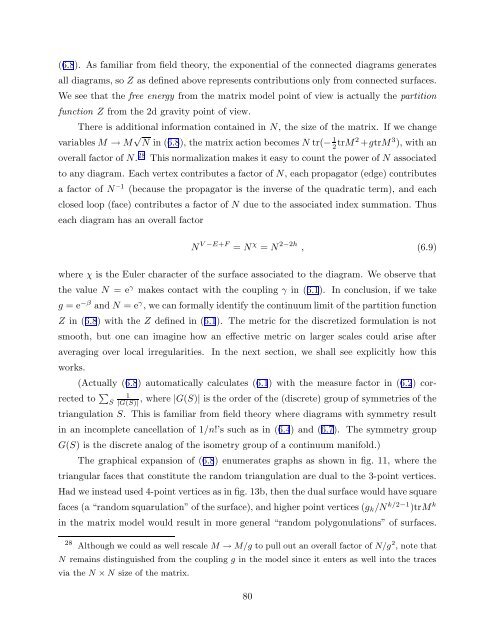arXiv:hep-th/9304011 v1 Apr 5 1993
arXiv:hep-th/9304011 v1 Apr 5 1993
arXiv:hep-th/9304011 v1 Apr 5 1993
Create successful ePaper yourself
Turn your PDF publications into a flip-book with our unique Google optimized e-Paper software.
(6.8). As familiar from field <strong>th</strong>eory, <strong>th</strong>e exponential of <strong>th</strong>e connected diagrams generates<br />
all diagrams, so Z as defined above represents contributions only from connected surfaces.<br />
We see <strong>th</strong>at <strong>th</strong>e free energy from <strong>th</strong>e matrix model point of view is actually <strong>th</strong>e partition<br />
function Z from <strong>th</strong>e 2d gravity point of view.<br />
There is additional information contained in N, <strong>th</strong>e size of <strong>th</strong>e matrix. If we change<br />
variables M → M √ N in (6.8), <strong>th</strong>e matrix action becomes N tr(− 1 2 trM 2 +gtrM 3 ), wi<strong>th</strong> an<br />
overall factor of N. 28 This normalization makes it easy to count <strong>th</strong>e power of N associated<br />
to any diagram. Each vertex contributes a factor of N, each propagator (edge) contributes<br />
a factor of N −1 (because <strong>th</strong>e propagator is <strong>th</strong>e inverse of <strong>th</strong>e quadratic term), and each<br />
closed loop (face) contributes a factor of N due to <strong>th</strong>e associated index summation. Thus<br />
each diagram has an overall factor<br />
N V −E+F = N χ = N 2−2h , (6.9)<br />
where χ is <strong>th</strong>e Euler character of <strong>th</strong>e surface associated to <strong>th</strong>e diagram. We observe <strong>th</strong>at<br />
<strong>th</strong>e value N = e γ makes contact wi<strong>th</strong> <strong>th</strong>e coupling γ in (6.1). In conclusion, if we take<br />
g = e −β and N = e γ , we can formally identify <strong>th</strong>e continuum limit of <strong>th</strong>e partition function<br />
Z in (6.8) wi<strong>th</strong> <strong>th</strong>e Z defined in (6.1). The metric for <strong>th</strong>e discretized formulation is not<br />
smoo<strong>th</strong>, but one can imagine how an effective metric on larger scales could arise after<br />
averaging over local irregularities. In <strong>th</strong>e next section, we shall see explicitly how <strong>th</strong>is<br />
works.<br />
(Actually (6.8) automatically calculates (6.1) wi<strong>th</strong> <strong>th</strong>e measure factor in (6.2) corrected<br />
to ∑ 1<br />
S |G(S)|<br />
, where |G(S)| is <strong>th</strong>e order of <strong>th</strong>e (discrete) group of symmetries of <strong>th</strong>e<br />
triangulation S. This is familiar from field <strong>th</strong>eory where diagrams wi<strong>th</strong> symmetry result<br />
in an incomplete cancellation of 1/n!’s such as in (6.4) and (6.7). The symmetry group<br />
G(S) is <strong>th</strong>e discrete analog of <strong>th</strong>e isometry group of a continuum manifold.)<br />
The graphical expansion of (6.8) enumerates graphs as shown in fig. 11, where <strong>th</strong>e<br />
triangular faces <strong>th</strong>at constitute <strong>th</strong>e random triangulation are dual to <strong>th</strong>e 3-point vertices.<br />
Had we instead used 4-point vertices as in fig. 13b, <strong>th</strong>en <strong>th</strong>e dual surface would have square<br />
faces (a “random squarulation” of <strong>th</strong>e surface), and higher point vertices (g k /N k/2−1 )trM k<br />
in <strong>th</strong>e matrix model would result in more general “random polygonulations” of surfaces.<br />
28 Al<strong>th</strong>ough we could as well rescale M → M/g to pull out an overall factor of N/g 2 , note <strong>th</strong>at<br />
N remains distinguished from <strong>th</strong>e coupling g in <strong>th</strong>e model since it enters as well into <strong>th</strong>e traces<br />
via <strong>th</strong>e N × N size of <strong>th</strong>e matrix.<br />
80
















